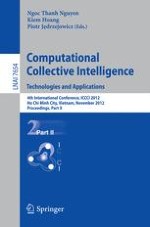The two volumes set LNCS 7653 and 7654 constitutes the refereed proceedings of the 4th International Conference on Computational Collective Intelligence, ICCCI, held in Ho Chi Minh City, Vietnam, in November 2012.
The 113 revised full papers presented were carefully reviewed and selected from 397 submissions. The papers are organized in topical sections on (Part I) knowledge integration; data mining for collective processing; fuzzy, modal, and collective systems; nature inspired systems; language processing systems; social networks and semantic web; agent and multi-agent systems; classification and clustering methods; modeling and optimization techniques for business intelligence; (Part II) multi-dimensional data processing; web systems; intelligent decision making; methods for scheduling; collective intelligence in web systems – web systems analysis; advanced data mining techniques and applications; cooperative problem solving; computational swarm intelligence; and semantic methods for knowledge discovery and communication
